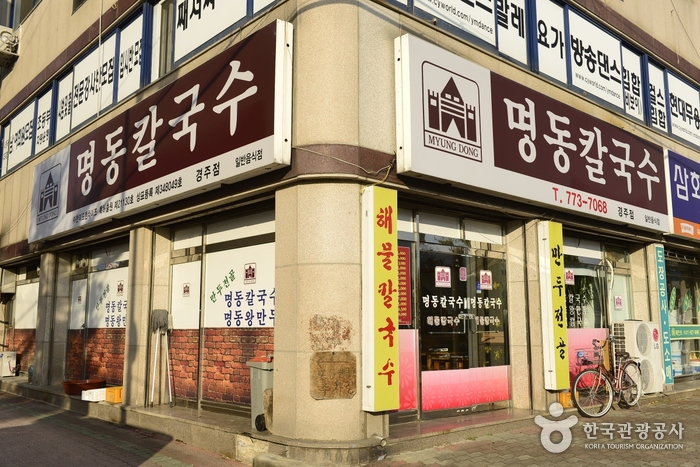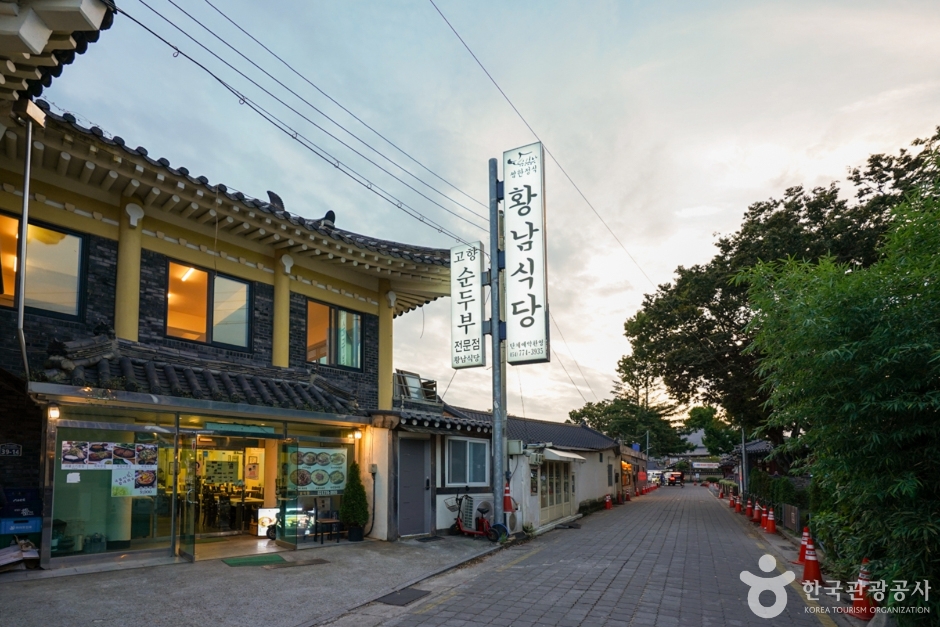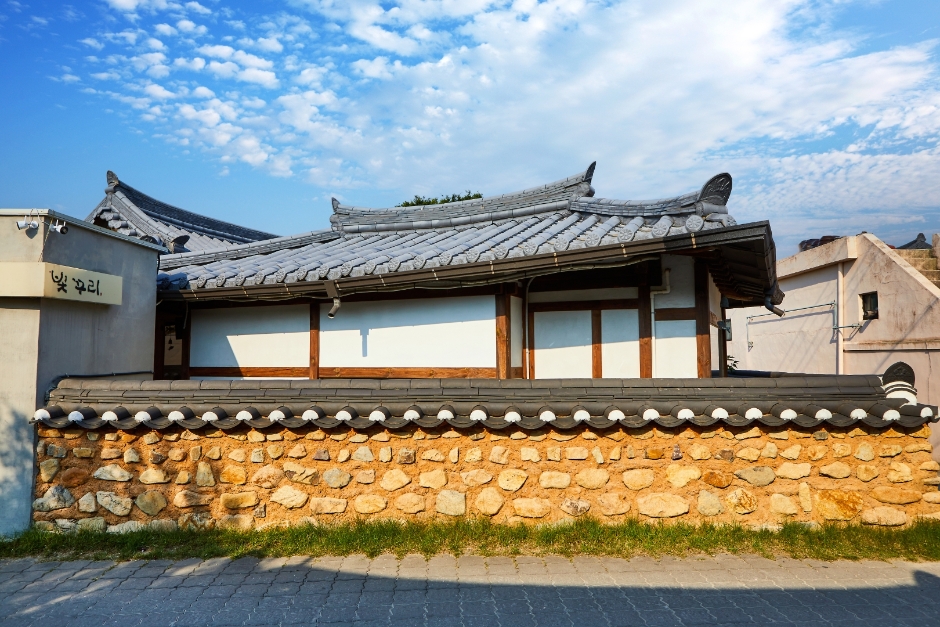Gyeongju Historic Area [UNESCO World Heritage] (경주역사유적지구 [유네스코 세계문화유산])
6.6 Km 55543 2022-05-11
757, Taejong-ro, Gyeongju-si, Gyeongsangbuk-do
+82-54-779-6100
The Gyeongju Historic Area, registered as a UNESCO World Cultural Heritage on November 2000, is an area that embodies the time-honored history and culture of Gyeongju, the ancient capital of the Silla Kingdom (57 BC-AD 935).
The Gyeongju Historic Area can be divided into 5 major sections. The first section is the Namsan Area, a treasure trove of Buddhist art masterpieces dating back to the Silla Kingdom. Gyeongju Namsan Mountain (often referred to as an ‘outdoor museum’) is home to many historical heritage sites from the Silla Kingdom. Major attractions include: Poseokjeong (Historic Site No.1), Tapgok Maaejosanggun (Treasure No. 201), Cheollyongsaji Three-story Stone Pagoda (Treasure No. 1188), Chilbulam Maae Stone Buddha (Treasure No. 200), Bulgok Seated Stone Buddha (Treasure No. 198), and 37 other Buddhist relics
The second section is the Wolseong Area, one of the former palace sites of the Silla Kingdom. The area consists of Gyerim (Historic Site No. 19); Donggung Palace and Wolji (Historic Site No. 18), a Silla Royal Palace site; and Cheomseongdae (National Treasure No. 31), the oldest observatory in the East. Daereungwon area, the third area, features a cluster of the royal graves of the Kings and Queens of Silla.
Also in the same area are Gobungun (a cluster of old graves) in Nodong-ri (Historic Site No. 38), Gobungun (a cluster of old graves) in Noseo-ri (Historic Site No. 39) Gobungun (a cluster of old graves) in Hwangnam-ri (Historic Site No. 40), and Oreung (Historic Site No. 172), among others. Archaeologists have discovered a number of invaluable relics and historic items in this area such as Geumgwan (golden crown), Cheonmado (a painting of flying horses), and numerous pottery pieces. These finds are perhaps the greatest clues into the life of the people of the Silla Dynasty.
Area number four, the Hwangnyongsa Area, is where the former site of the Hwangnyongsa Temple (Historic Site No. 246) and Bunhwangsa Stone Pagoda are located. Lastly, is the Sanseong Area, housing remnants of the major defense system for the capital city. The site consists of Myeonghwalsanseong Fortress (Historic Site No. 47) which is estimated to be around 400 years old.
The Gyeongju Historic Area has a total of 52 designated cultural assets that are registered as World Cultural Heritages.
Myeongdong Kalguksu (명동칼국수)
6.6 Km 4570 2024-02-28
46-4 Yongdam-ro, Gyeongju-si, Gyeongsangbuk-do
Myeongdong Kalguksu is a noodle restaurant specializing in kalguksu (noodle soup), located near Gyeongju Hwangseong Park. It offers kalguksu, haemul kalguksu (noodle soup with seafood), mandu jeongol (mandu hot pot), and more, prepared with chewy noodles and rich anchovy broth. After your meal, you can explore nearby attractions such as Gyeongju Civic Stadium, Arts Center, and Bitnuri Garden, as this area is rich in the cultural and historical heritage of the Silla dynasty.
Hwangseong Park (황성공원)
6.6 Km 28363 2024-02-23
431-12 Wonhwa-ro, Gyeongju-si, Gyeongsangbuk-do
Situated near the Gyeongju Municipal Library and Gyeongju Arena, Hwangseong Park is notable for its dense forest populated with stunning pine trees and centuries-old trees. During summer, it becomes a haven for blooming Lilyturfs, while in autumn, ancient trees such as zelkova and oak showcase vibrant colors, enhancing the natural beauty of the area. Within the park, visitors can find the Statue of General Kim Yusin, a Korean archery range, and a Ssireum (Korean traditional wrestling) ring. Nearby attractions include Gyeongjueupseong Walled Town, Cheonmachong Tomb, Daereungwon Ancient Tombs, and Hwangnidan Street.
Hanokinn [Korea Quality] / 한옥人(한옥인) [한국관광 품질인증/Korea Quality]
6.7 Km 3 2021-03-29
19, Poseok-ro 1050beon-gil, Gyeongju-si, Gyeongsangbuk-do
This hanok (traditional Korean house) is located at the center of Hanok Conservation Area, known as Hwangnidan-gil Street. To the north lies the old alley that connects to Cheomseongdae Observatory. The house has sarangchae building, byeolchae building, and main building, which is used as a gallery and café, surrounding the grass lawn in the center. All rooms are equipped with ondol (under-the-heating system) and a red clay finish, and each room has a bathroom with shower facilities.
Sarangchae is a two-story hanok building with a hipped-and-gable roof. Its first floor is occupied by a double room and a family room, which can support up to 4 people. Byeolchae is a single-floor hanok with a gable roof, containing two double rooms and a raised floor space. The main building’s gallery contains a hanok experience room, cafe, restaurant, and a traditional tea room. A Korean-style breakfast is offered in the cafe, and the management also offers experience programs like tea ceremony, traditional games like yunnori (board game), and traditional musical instruments like janggo (hourglass-shaped drums) and gayageum (twelve-stringed zither).
Gyeongju Ssambap Street (경주 쌈밥거리)
6.7 Km 0 2024-02-08
9 Gyerim-ro, Gyeongju-si, Gyeongsangbuk-do
Gyeongju Ssambap Street, developed around the Daereungwon Ancient Tombs in Gyeongju, offers a diverse culinary experience. A highlight is ssambap (leaf wraps and rice), a dish featuring fresh vegetables accompanied by substantial side dishes like fish, meat, and doenjang jjigae (soybean paste jjigae) made from homemade soybean paste. Additionally, this street presents a variety of snacks, including Hwangnam ppang (Hwangnam bread) prepared with red beans and flour, and jjondeugi, a traditional chewy snack made from cornmeal and sugar. Nearby attractions include the Cheomseongdae Observatory, Donggung Palace and Wolji Pond, Woljeonggyo Bridge, and the Gyeongju National Museum.
Gyeongju Daereungwon Ancient Tomb Complex (경주 대릉원 일원)
6.7 Km 13734 2022-12-26
9, Gyerim-ro, Gyeonju-si, Gyeongsangbuk-do
+82-54-750-8650
Gyeongju Daereungwon Tomb Complex consists of five tombs, Ancient Tombs of Gyeongju Nodong-ri, Noseo-ri, Hwangnam-ri, Hwango-ri, and Inwang-ri. The tombs are distributed in Hwangnam-dong, Gyeongju-si, and are located in the Daereungwon area. Within Daereungwon Tomb Complex is Cheonmachong Tomb, which was excavated in 1973. Furthermore, Hwangnamdaechong Tomb was excavated between 1973 and 1975, and is a set of twin tombs belonging to a presumed married couple.
Gyeongjuhanok 1st [Korea Quality] / 경주한옥1번가 [한국관광 품질인증]
6.7 Km 949 2023-10-25
20 , Cheonwon 1-gil, Gyeongju-si, Gyeongsangbuk-do
+82-10-9505-5367
Standing at the entrance of Cheonwon Village in Gyeongju, Gyeongsangbuk-do, Gyeongju Hanok First is a hanok stay combining the beauty of tradition with modern convenience. All rooms are Korean-style with comfortable bedding on the floor, and all have a toilet and bathroom. One guestroom has its own kitchen, while the others have basic cooking facilities in a shared kitchen. The spacious yard is decorated with figurines in traditional clothes. Nearby tourist attractions include Anapji Pond, Cheomseongdae Observatory, and Gyeongju Museum.
Bitgguri (빛꾸리)
6.7 Km 1 2023-07-12
16-1 , Sonhyoja-gil, Gyeongju-si, Gyeongsangbuk-do
+82-54-777-4421
This cafe is located in a small alley near Cheonmachong Tomb (Daereungwon Ancient Tombs), in a renovated old hanok and yard. This place's seating is on the floor, so the traditional atmosphere comes alive. Bitgguri’s signature menu items are grilled saekdong injeolmi (bean-powder-coated rice cake) and tangerine ginger tea. Dig into the colorful rice cakes, grilled and coated with powdered soybeans, and traditional tea to fully enjoy the classic charms of Gyeongju. The rice cake is enjoyed together with a malt syrup called jocheong, a traditional substitute for honey. Tangerine ginger tea is a traditional tea made with tangerine and ginger. It is quite effective for colds and is full of natural vitamins, so one can feel healthy just by drinking the beverage. The café has a garden decorated with traditional earthenware pots and stone fences topped with tiles, allowing one to enjoy a charming view along with the dessserts. The cafe also hosts one-day classes, such as bojagi (square clothes made to be wrapped around items for transportation) making.
Cheonmachong Tomb (Daereungwon Ancient Tombs) (천마총 (대릉원))
6.7 Km 110909 2023-07-14
9, Gyerim-ro, Gyeongju-si, Gyeongsangbuk-do
+82-54-743-1925
Daereungwon Ancient Tombs are one of the most well-known sights in Gyeongju, a history park home to 23 small and large ancient tombs. The area is dotted with tranquil trails among the tombs like the largest tomb in Hwangnam-dong, Hwangnamdaechong Tomb; Cheonmachong Tomb, the place where Cheonmado, a saddle flap painting, was excavated from; and the tomb of King Michu, nicknamed the “Tomb of the Bamboo Warrior.”
Cheonmachong Tomb, excavated in 1973, has a x_height of 12.7 meters and a diameter of 50 meters. Its excavation unearthed many artifacts, such as the famous Gold Crown from Cheonmachong Tomb. Its name comes from Cheonmado, a mudguard saddle flap with a painting of a heavenly horse. Cheonmachong Tomb is the only tomb in the Daereungwon Ancient Tombs to be opened to the public.
The tomb is thought to have been constructed between the late 5th century and early 6th century. Artifacts excavated from the tomb include a gold crown, gold cap, gold waist belt, gold diadem, and gilt-bronze shoes worn by the buried. The gold crown, in particular, is known as the largest and the most elaborate of all gold crowns unearthed in Korea. The artifacts themselves can be found in Gyeongju National Museum, so don’t miss the chance to see them in person.
Another must-visit site is the Daereungwon Magnolia Photo Area, a lone magnolia tree standing between the beautiful curves of ancient tombs.
Wadamjung [Korea Quality] / 와담정 [한국관광 품질인증]
6.7 Km 814 2020-09-09
18, Cheonwon 1-gil, Gyeongju-si, Gyeongsangbuk-do
+82-54-772-5400 / +82-10-6571-3412
Wadamjung in Cheonwon Village, Gyeongju is a modern traditional Korean guesthouse built in May 2017, with both the features of a traditional Korean house and modern facilities such as air conditioner and bathroom. It has a total of nine guestrooms that can accommodate three to six people, and there is a kitchen that can be shared among the guests. A large group can book a stand-alone guestroom that can accommodate up to 12 people, inclusive of a kitchen. There are various traditional artifacts and items with which to play a traditional game in the large yard, such as Jegi (Korean shuttlecock game) and Tuho (Arrow-throwing). In addition, there are a number of tourist destinations such as Cheomseongdae in Wolseong District, with lots of historical sites in Gyeongju as well as Gyeongju National Museum.
![Gyeongju Historic Area [UNESCO World Heritage] (경주역사유적지구 [유네스코 세계문화유산])](http://tong.visitkorea.or.kr/cms/resource/03/2656603_image2_1.jpg)


![Hanokinn [Korea Quality] / 한옥人(한옥인) [한국관광 품질인증/Korea Quality]](http://tong.visitkorea.or.kr/cms/resource/65/2707565_image2_1.jpg)

![Gyeongjuhanok 1st [Korea Quality] / 경주한옥1번가 [한국관광 품질인증]](http://tong.visitkorea.or.kr/cms/resource/15/3021415_image2_1.jpg)

![Wadamjung [Korea Quality] / 와담정 [한국관광 품질인증]](http://tong.visitkorea.or.kr/cms/resource/35/2557635_image2_1.jpg)
 English
English
 한국어
한국어 日本語
日本語 中文(简体)
中文(简体) Deutsch
Deutsch Français
Français Español
Español Русский
Русский